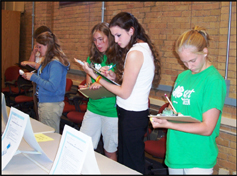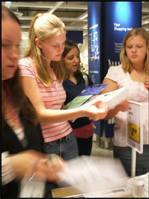February 2008 // Volume 46 // Number 1 // Ideas at Work // 1IAW4
Strengthening 4-H Youth Consumer Decision-Making Skills: Contest to Community Service
Abstract
The University of Minnesota Extension 4-H Consumer Decision Making program strengthens youth consumer decision-making skills by connecting the contest to service learning. The program uses experiential learning to teach youth to make wise consumer decisions. Youth participate in a judging contest where they rank consumer items based on criteria. Youth gain experience in organizing thoughts and defending decisions with oral reasons. Youth also participate in a "group process" activity where they gain experience with decision making as a team member. Participants are also involved in an educational activity with a community service-learning component that allows more in-depth learning.
Introduction
Youth make decisions every day. Financial decisions can range from deciding which item to purchase for a snack to which cell phone plan meets one's needs. Practicing decision making increases the chances that youth will make good decisions (Welker, 1998). The 4-H Consumer Decision Making program provides a venue for youth to learn and practice the crosscutting life skill of decision making.
The University of Minnesota Extension program also incorporates the experiential learning model by bridging the youth's newly acquired knowledge and skills to an awareness and response to local needs. The program continuum includes team practice on the county level with a caring volunteer coach, regional and state contests, and a state service learning activity that culminates in community service in their local county.
Description
Contest
The Consumer Decision Making program began as a home economics contest and provides an opportunity for youth outside of the livestock project areas a chance to learn from a judging experience. The 4-H Consumer Decision Making program helps youth prepare for the future by teaching them how to observe, compare, and make decisions based on a given situation. Using pre-written scenarios as a teaching technique is a recommended learning method for decision-making skills (Dydal & Sondag, 2000).
The judging process provides experience in organizing thoughts and defending decisions with oral reasons. In this program the youth participate in a judging contest where they rank articles or products over others based on criteria, standards, and quality. 4-H'ers review scenarios as in Figure 1, evaluate consumer items, and tell why they think one is better than another. Previous research on livestock judging programs indicate that participation in judging has influenced the development of several life skills, including: the ability to verbally defend a decision, work together as a team, solve problems, communicate effectively and make wise decisions (Rusk, Martin, Talbert, & Balschweid, 2002; Nash & Sant, 2005).
Figure 1.
Participants Judging Class

Contest Components
Individually, participants:
- Judge five classes:
- Health & nutrition
- Clothing & textiles
- Entertainment & leisure
- Consumerism/personal finance
- Personal care products
- Complete questions on one identified class
- Orally present reasons on identified class(es)
As a group:
- Teams participate in a Group Process
activity, utilizing the following decision-making model to assess a
given situation, determine an outcome, and present their decision:
- Ascertain the issue or problem and state the facts
- Determine the alternative solutions to the problem
- List the personal or social goals (or criteria) bearing on the problem
- Evaluate the alternatives according to the goals or criteria
- Make a decision based on the evaluation
Service Learning Activity
Most judging contests end when the judging is completed. The Minnesota program is unique in that the state contest involves an educational activity that allows more in-depth learning for the youth along with a service-learning component. With assistance from university specialists, the youth learn about issues in our Minnesota communities (such as family costs for food, shelter and clothing), purchasing strategies, and participate in a shopping experience. During a shopping experience (Figure 2), each team receives a set dollar amount to purchase items, based on a given set of criteria (e.g., budget, quality, need) and defends their choices to the large group based on the given criteria.
Figure 2.
Participants Evaluate Product
Options for Purchase

Upon returning to their home communities, the youth donate the products to a non-profit entity to be used by low-income families. In addition to donating the product, teams are encouraged to donate time and learn more about the issues. The service-learning component allows youth to practice life skills (Hariston, 2004). The service learning activity completes the experiential learning process by generalizing what they have learned to connect the experience to a real-world situation and by applying what was learned with others in their community.
Service Learning Activity Components
- Faculty presentation
- Hands-on site-based experience
- Tour facility
- Teams make purchasing decisions based on given situation
- Teams report back to the large group decisions made
- Service learning
- Teams donate purchased items and volunteer time to non-profit organizations in their home community
Program Evaluation
Participants completed a written end of session evaluation that included questions to collect quantitative data about the increase of knowledge acquired as a result of the experience and open-ended questions to collect qualitative data from participants.
End of program evaluation results from 2005 and 2006 completed by 112 youth indicate that youth decision-making skills have been enhanced. Youth report that as a result of participating in the 4-H Consumer Decision Making program they:
- Are more competent in making consumer decisions (97%)
- Are more confident in making consumer decisions (95%)
- Expand communication skills (92%)
- Commit to share their experience and expertise on consumer decision making with others (88%)
- Commit to apply what they have learned about consumer decision making in their personal lives (96%)
- Prepare for the future by learning to reason, recognize quality products, and to make decisions based on a given situation (96%)
- Commit to share their time and resources with local community non-profit agencies (80%)
In response to the question "The most important thing I have gained from participating in the Consumer Decision Making program is," youth replied: "I have learned how to better spend my money and what to look for to make good consumer decisions"; "The ability and skills to have a clear thought process while shopping and purchasing items"; "That name-brand stuff isn't always important, the generic kind can taste just as good."; and "The contest is a ton of fun and it teaches a lot about making smart choices."
These findings are consistent with previous research conducted by Rusk et al. (2002) and Nash and Sant (2005) on 4-H livestock judging programs. Evaluations from livestock judging and consumer decision making judging both report growth in communication skills, problem solving, and decision making. It appears that connecting a consumer decision-making contest to a community service learning activity strengthens 4-H youth's consumer decision-making skills.
Conclusions
The opportunity to learn and practice critical decision-making skills is provided through the University of Minnesota Extension 4-H Consumer Decision Making program. The program is strengthened by the involvement of field and campus faculty, 4-H Youth Development and Family Development staff, as well as volunteers. Participants appreciate the "real life" experience with a purpose, actually applying what they learned to make real life purchasing decisions and then donating items and time to a community organization. The service-learning component extends the learning for participants. Funds need to be secured to support the service-learning component.
The evaluation provides an opportunity for participants to have ownership of the program, providing feedback that will be used for the following year's planning, as well as validating the learning. The program needs to be current to appeal to youth's interests. The authors believe it is critical for Extension to allocate resources to support this program because decision making is a critical, crosscutting skill that is vital for the success of today's youth.
References
Dybdal, L., & Sondag. K. A. (2000). Developing decision-making skills through the use of critical incidents. Journal of Health Education, 31(2), 115-118.
Hairston, J. E. (2004). Identifying what 4-H'ers learn from community service learning projects. Journal of Extension [Online], 42(1). Available at: http://www.joe.org/joe/2004february/rb4.shtml
Nash, S. A., & Sant, L. L. (2005). Life-skill development found in 4-H animal judging. Journal of Extension, [On-line], 43(2) Article 2RIB5. Available at: http://www.joe.org/joe/2005april/rb5.shtml
Rusk, C. P., Martin, C. A., Talbert, B. A., & Balschweid, M. A. (2002). Attributes of Indiana's 4-H livestock judging program. Journal of Extension, [On-line], 40(2). Available at: http://www.joe.org/joe/2002april/rb5.html
Welker, E. (1998). Decision making/problem solving with teens (Ohio State University Extension Factsheet Publication No. HYG-5301-98). Columbus, Ohio: The Ohio State University Extension. Retrieved June 1, 2007 from: http://ohioline.osu.edu/hyg-fact/5000/5301.html
